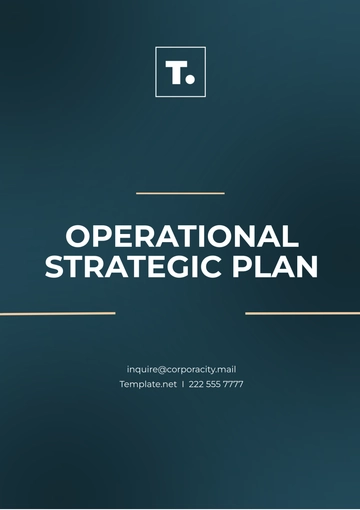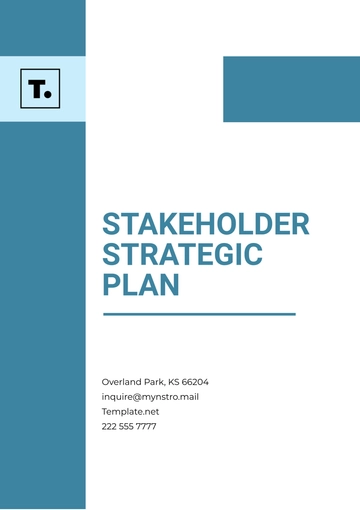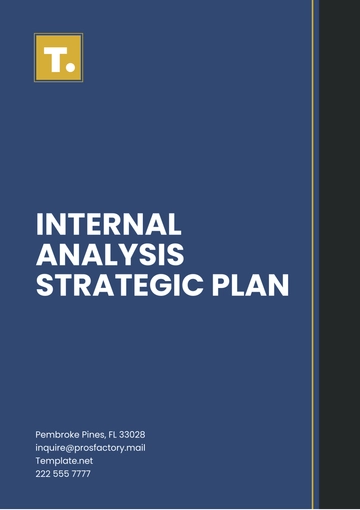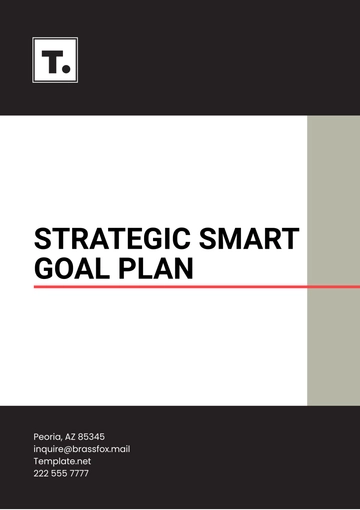Free Aesthetic 5-Year Business Strategic Plan

Prepared By: [Your Name]
Date: June 12, 2060
1. Executive Summary
The 5-Year Strategic Plan outlines the goals, key initiatives, and tactical approaches aimed at driving [Your Company Name]'s growth and profitability from 2060 to 2065. This plan focuses on expansion into new markets, technology innovation, and enhancing operational efficiency. Key outcomes include increasing revenue by 30%, improving market share by 15%, and optimizing internal processes to achieve cost reductions of 10%.
Key Focus Areas: Market expansion, technological innovation, operational excellence, customer satisfaction
Strategic Goals: Enhance brand presence, increase product offerings, improve operational efficiency
Expected Impact: Increased revenue, improved brand recognition, sustainable growth
2. Mission and Vision Statements
Mission Statement:
"To provide innovative solutions that empower businesses to thrive in a constantly evolving market, while delivering exceptional value to our customers, employees, and stakeholders."Vision Statement:
"To become a global leader in [Industry], driving innovation and sustainability, with a commitment to long-term growth and stakeholder success."
3. SWOT Analysis
A. Strengths:
Strong brand equity and customer loyalty
Leading-edge technology in [Product/Service]
Strong R&D capabilities
Skilled leadership and experienced workforce
B. Weaknesses:
Limited presence in emerging markets
Dependence on a few key products
Operational inefficiencies in the supply chain
C. Opportunities:
Emerging market potential in [Region]
Growing demand for eco-friendly products
Strategic partnerships and acquisitions
Expanding online presence
D. Threats:
Increased competition from [Competitor]
Regulatory changes in [Region/Market]
Economic downturn risks
Supply chain disruptions
4. Goals and Objectives
Increase Market Share by 15% by 2065
Expand into 3 new international markets (target regions: Region 1, Region 2, Region 3).
Launch new products in the [Product Category].
Achieve Revenue Growth of 30% by 2065
Introduce two new revenue streams within 3 years.
Increase product sales in existing markets by 10%.
Reduce Operational Costs by 10% by 2065
Implement automation in 50% of the production line by 2062.
Optimize the supply chain and reduce shipping costs by 15%.
5. Key Strategies and Initiatives
Market Expansion:
Launch in New Market 1 by Q2 2061.
Strengthen presence in existing markets through digital marketing and local partnerships.
Product Innovation:
Develop and launch [New Product/Service] in 2062.
Introduce a new product line aimed at specific customer segments.
Operational Excellence:
Invest in automation technology to increase production efficiency by 20%.
Streamline supply chain by working with key logistics partners.
Sustainability Initiatives:
Reduce carbon footprint by 25% by 2065.
Introduce green technology and eco-friendly products by 2063.
6. Resource Allocation and Budget
A. Budget Allocation:
R&D (20%): $10,000,000
Focus on research for new products, improving existing products, and investing in new technologies, including artificial intelligence and automation systems.Marketing and Sales (25%): $12,500,000
Allocate funds for digital marketing campaigns, influencer partnerships, targeted advertisements, global expansion marketing, and trade shows.Product Development (15%): $7,500,000
Invest in developing and testing new products, launching new product lines, and improving product features based on market feedback.Operations (10%): $5,000,000
Operational improvements, including automation of manufacturing processes, upgrading supply chain management systems, and increasing production capacity.Sustainability Initiatives (10%): $5,000,000
Focus on renewable energy sources, reducing carbon emissions, and implementing sustainable packaging solutions and eco-friendly production methods.Human Resources and Training (10%): $5,000,000
Investment in recruitment, employee training programs, leadership development, and fostering a culture of innovation and collaboration.Contingency (10%): $5,000,000
Reserve funds for unexpected challenges such as market shifts, supply chain disruptions, or economic downturns.
B. Projected Revenue:
Year 1 (2060): $60,000,000
Expected revenue from existing product lines and initial market expansion efforts. Focus on enhancing brand recognition and securing partnerships.Year 2 (2061): $75,000,000
Revenue growth is driven by the launch of new products and expansion into new regions such as Region 1 and Region 2.Year 3 (2062): $90,000,000
Increased revenue from established products and the scaling of new product lines. Operational efficiencies will start yielding returns.Year 4 (2063): $100,000,000
Continued market expansion, leveraging digital sales platforms, and optimizing global operations. Additional revenue streams are produced from new product categories.Year 5 (2064): $120,000,000
Achieving significant revenue milestones with global market penetration, the scaling of innovations, and strategic acquisitions.
7. Timeline and Milestones
Year 1 (2060):
Finalize market expansion strategy.
Begin product development for [New Product].
Year 2 (2061):
Launch in [New Market 1].
Launch product [New Product].
Year 3 (2062):
Expand operational capacity with automation.
Assess market reception of new products and adjust accordingly.
Year 4 (2063):
Implement sustainability initiatives.
Achieve 50% of sales from new product lines.
Year 5 (2064):
Assess progress toward 30% revenue growth.
Prepare for new product launches in [Region].
8. Risk Assessment and Contingency Plans
A. Potential Risks:
Economic Uncertainty: Adjust revenue projections and explore additional revenue streams.
Regulatory Challenges: Regularly monitor changes in international market regulations and adjust business strategies accordingly.
Supply Chain Disruptions: Diversify suppliers and invest in risk management systems to monitor potential disruptions.
B. Contingency Plans:
Have backup suppliers in place for key materials.
Maintain a flexible budget for unforeseen expenses.
Adjust timelines for market entry if external factors delay progress.
9. Evaluation and Key Performance Indicators (KPIs)
KPIs:
Market Share Growth: Target a 15% increase by 2065.
Revenue Growth: 30% increase by 2065.
Cost Efficiency: Achieve a 10% reduction in operational costs.
Customer Satisfaction: Achieve a satisfaction rate of 90% in customer surveys.
Employee Engagement: Maintain a 95% employee retention rate.
Evaluation Process:
Quarterly progress reports.
Annual reviews of financials and operational outcomes.
Mid-year reviews of product performance and customer feedback.
10. Review and Adaptation Process
Annual Strategic Reviews:
Conduct an annual review of the strategic plan to ensure it remains aligned with market changes and business goals.
Modify goals or strategies as needed based on market conditions, competition, and internal performance.
Key Review Sessions:
Executive meetings will be held at the end of each year to analyze progress, adjust forecasts, and plan for the next phase.
- 100% Customizable, free editor
- Access 1 Million+ Templates, photo’s & graphics
- Download or share as a template
- Click and replace photos, graphics, text, backgrounds
- Resize, crop, AI write & more
- Access advanced editor
Achieve strategic growth with elegance using this Aesthetic 5-Year Business Plan Template. Fully customizable and editable in Template.net’s Ai Editor Tool, it’s designed to align your business objectives with visual appeal for a professional, polished presentation.





























